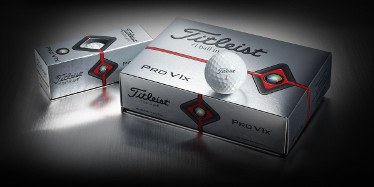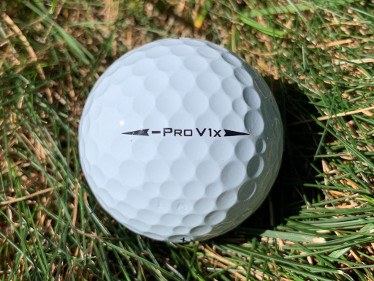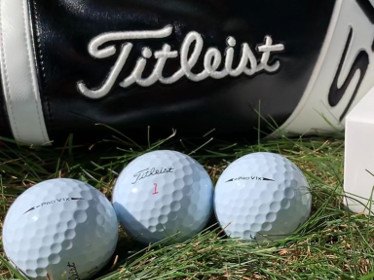
© TITLEIST Golf
Titleist ProV1x: Lower Golf Ball Flight, Same Great Performance
Ball tested: Titleist ProV1x
Category*: Tour/Advanced/Performance
Specs: Construction – Four-piece; Cover – Urethane Elastomer (proprietary material); Core – High-velocity dual core; Dimples / Pattern – 328 dimples in what Titleist terms a spherically tiled tetrahedral design
Compression: High Pro V 1x high 90s compression
Price as tested (new): MSRP – $62 per dozen; widely available for less than $50

Ball notes: The sibling to Titleist’s original ProV1, the ProV1x is designed to generate a little less spin and an uptick in distance off the tee, with a slightly firmer feel than its twin. Like the ProV1, the ProV1x is immensely popular among tour pros; as of May 2013, Luke Donald, Steve Stricker, Lee Westwood and Bubba Watson were just a handful of those using it.
Obviously, this ball is made for very good golfers with high swing speeds (100+ mph) and the skill to play a variety of shots from inside 100 yards. However, it is durable enough to withstand a fair amount of punishment via miss-hits, trees, cart paths and the like.
Sound and feel: Two words – typical Titleist. The ProV1x may be firmer than the ProV1, but we could scarcely tell a difference. It’s about as soft as a modern ball gets, with the urethane cover delivering a distinctive squish on impact. The sublime sound and feel are especially noticeable – and gratifying – when putting.

Off the tee: While we don’t have launch monitor data to confirm it, our eyes tell us the ProV1x does indeed fly a little lower than the ProV1. Paired with a lower spin rate, this makes the ProV1x a great ball for windy days and/or firm fairway conditions. It’s also highly workable for golfers capable of shaping draws and fades.
From the fairway / rough: Not to sound like a broken record, but we detected a lower trajectory with the ProV1x with hybrids and irons, too. The difference is more marked in the short irons, which launch with a beautiful, penetrating flight. Spin is superb – if you hit a solid shot, the ProV1x will stop on a dime. Nip it just a touch thin and it’ll still check up nicely.
Around the green: The short game is all about feel and confidence, and the ProV1x provides plenty of both. If you can envision and execute a shot – be it a low, checking chip or a butterfly-soft lob – this ball will respond.
Bottom line: Honestly, it probably takes a tour pro’s touch and precision to tell a major difference between the ProV1x and its stable mate. That said, we noticed enough divergence in ball flight with the driver and short irons to recommend the ProV1x to golfers who prefer a lower flight, or who simply want to reduce the height of their shots. Better players can’t go wrong with either ball.
Golf Ball Videos:
- Compression Video
- Spin Video
- Dimples Video
- Golf Ball Brands Video
- Titleist Video
- Understanding Spin Video
Categories Explained:
Value/Recreational/Distance – Designed for mid- to high-handicap golfers with swing speeds below 90 mph; typically feature two-piece construction and firm covers; promote greater distance over high spin rates. Examples: Pinnacle Gold, Slazenger RAW Distance
Premium – Designed for low- to mid-handicap golfers with swing speeds of 90-99 mph; typically feature multi-layer construction and medium-soft covers; happy medium between Value/Recreational and Tour categories for distance and spin qualities. Examples: Titleist NXT Tour, Callaway HEX Diablo
Tour/Advanced/Performance – Designed for low-handicap and professional golfers with swing speeds in excess of 100 mph; typically feature multi-layer construction and soft covers; promote greater spin rates and enhanced feel over distance. Examples: Titleist ProV1, Bridgestone Tour B330
Titleist Left Dash Pro V1x Hits Retail

If you’re a big fan of the brand, and if you’re serious about golf (you probably are since you’re here), the good news for today is that Titleist announced that starting with October 1st, their latest Pro V1x golf ball will hit retails stores worldwide. And obviously we’re talking about the “left dash” version; now, if you’re wondering about the nomenclature, the “dash” thing refers to the printing on the ball’s cover, which reads <-PRO V1x> or something similar. Basically, there’s a dash printed to the left of the Pro V1x branding. It’s worth mentioning that the ProV line from Titleist has seen a few extensions during their life-cycle, starting with the introduction of the first generation, at some point back in 2003, as our seasoned readers may remember. But what’s really important is that the only multi-piece urethane covered ball launched in North America is the Titleist AVX, which is aimed at golfers looking for decreased spin and lower overall flight due to its lower compression/lower trajectory features.

That until now: enter the <-PRO V1X>, also known as “performance overwhelming”, a high-end golf ball that makes for a lower spinning/higher launching version of the legendary ProV1X. If you remember one of our latest articles, the Titleist AP3 was recently replaced by the T200 (the equivalent) in order to fill a gap in the company’s iron line, between the AP2 and AP1 irons respectively. The same principle applies to the <-PRO V1X> golf ball, which comes with basically the same tech specs and characteristics of the AVX, but features a way higher compression core; more precisely, the <-PRO V1X> is similar in this regard to the ProV1 X.
Who’s it for, you asked? The target is professional players and elite amateurs, i.e. hardcore golfers looking for a higher compression golf ball, but still require a lower spinning version. And if you think that’s not a big deal, you should learn that developing a performance golf ball, that type of golf gear Tour players use, it’s a very difficult task that takes years of research and development, not to mention million dollar budgets. Then, there’s the issue of convincing Tour players to take them for a drive, in order to deliver in-game feedback and so on and so forth.

The Left Dash Pro V1x has an interesting story in this regard, as it basically started as a prototype in order to collect real-time feedback on the new technology from Titleist staff, i.e. pro-golfers took it for a spin in order to see how the core technology paired with a brand new cover works in real life. The feedback was very encouraging, as the ball became highly popular, thus it justified keeping it as a custom performance option, or a CPO. A custom performance option is built in the same plant on the same gear as other mass-production golf balls, but in smaller quantities, and obviously, using different materials. Think along the lines of gluten free biscuits, as they’re basically the same biscuits crafted for people that really need them.
The “gluten free” Left Dash Pro V1x golf ball was incredibly tasty, if we may say so, and it ended up (truth be told, it was eventually refined and improved and all that) as the 2017 ProV1X, but due to its special characteristics, there are still some folks out there that prefer the “original recipe”. Here’s the official explanation coming directly from the horses’ mouth, and by that we mean Titleist’s VP of Golf Ball Marketing Michael Mahoney:
“Through our player testing, we realized that some of our players were seeing slightly better performance out of our CPO products. It doesn’t mean they were losing performance with other products, but when you are working with the best players in the world some just have specific requirements.”

Yes, there are special people with special needs out there, and that also applies to the golf world. All jokes aside, there’s a relatively small number of players who still use a Titleist CPO, and, truth be told, the Left Dash Pro V1x is not meant as a golf ball for the masses, as it doesn’t really fit a large number of players. According to Titleist, fifteen percent tops of Tour players are going to use it, or so claims Michael Mahoney:
“The way we have looked at it is, if there is enough demand for a product through our channels, then we want to make it available to the public. “Almost 90% of the products we sell are custom fit for the consumer, if we can go one step further and offer that with a ball, even better!”
To give you a little bit of context, the new Left Dash Titleist Pro V1x can be compared to Titleist MOTO gear , also known Made Only To Order products; think along the lines of the 917D4, a small market segment product aimed at golfers looking for low spin gear. After all’s said and done, starting with October 1st, you’ll be able to order the new Pro V1x Left Dash, that provided you have a Titleist account. Depending on your location, you’ll have to pay $48 at the vast majority of retailers for a dozen of these magnificent balls, provided that’s your cup of tea.
Golf Ball Videos:
- Compression Video
- Spin Video
- Dimples Video
- Golf Ball Brands Video
- Titleist Video
- Understanding Spin Video
Categories Explained:
Value/Recreational/Distance – Designed for mid- to high-handicap golfers with swing speeds below 90 mph; typically feature two-piece construction and firm covers; promote greater distance over high spin rates. Examples: Pinnacle Gold, Slazenger RAW Distance
Premium – Designed for low- to mid-handicap golfers with swing speeds of 90-99 mph; typically feature multi-layer construction and medium-soft covers; happy medium between Value/Recreational and Tour categories for distance and spin qualities. Examples: Titleist NXT Tour, Callaway HEX Diablo
Tour/Advanced/Performance – Designed for low-handicap and professional golfers with swing speeds in excess of 100 mph; typically feature multi-layer construction and soft covers; promote greater spin rates and enhanced feel over distance. Examples: Titleist ProV1, Bridgestone Tour B330

© TITLEIST Golf
Titleist ProV1x (2015 model): Softer Feel, More Spin, Same Great Performance
Ball tested: Titleist ProV1x (2015 model)
Category*: Tour / Advanced / Performance
Feel: Soft
Tested for golfers with average driving distance of: 196 to 300+ yards (carry + roll)
Specs: Construction – Four-piece; Cover – Thermoset urethane elastomer; Core – ZG Process Technology; Dimples / Pattern – 328 in what Titleist terms a spherically tiled tetrahedral design
Compression: High
Price as tested (new): $62 per dozen, but widely available for $50 or less
Ball notes: What does the x stand for? Nothing specific. But Titleist’s ProV1x does offer slight variations on its sibling, the ProV1.

In fact, the newest ProV1x, rolled out in 2015, has undergone a mild makeover itself. It’s always been a touch firmer than the ProV1, while launching a little higher and spinning a little less. (Its intended audience is golfers with high swing speeds who create plenty of backspin on their own.) While it still meets those criteria, the redesigned ProV1x features a softer cover for a feel that’s more in line with other balls in its category.
The new ProV1x has certainly made its mark on the PGA TOUR. Bubba Watson, Jordan Spieth and Bill Haas are among the pros playing and praising it.
Not content to take their word for it, we put the revamped Titleist ProV1x through the paces to judge for ourselves. Our impressions follow. (Note: We reviewed the 2015 ProV1, too.)
On the clubface: Titleist’s lab rats tweaked the recipe for the ProV1x’s thermoset urethane elastomer cover, with the goal of making it softer yet more durable. Mission: Accomplished. While it’s still a relatively firm ball, the new ProV1x is definitely softer than previous versions.

Golfers who can swing the driver at 105-plus mph will likely notice – and approve of – the difference. They’ll also be glad Titleist didn’t go too far in softening up the ProV1x.
Off the tee: The new ProV1x retains the older model’s high-launch qualities. If anything, it may fly a bit higher now. Sidespin remains dampened, making this a very straight ball. And it’s just workable enough to hit draws and fades with the driver, if that’s your game.
From the fairway / rough: We started to really notice the softer feel of the new ProV1x with the mid- and short irons. As always, this ball carries high and drops abruptly. It’s a fantastic choice for courses with firm greens and/or tucked pins. Despite the high trajectory, the ProV1x showed solid stability in the wind.
Around the green: The true proof of the ProV1x’s softer, spinnier cover came in short game testing. The gap in greenside spin between the ProV1 and ProV1x is narrower now, with the latter gaining considerable ground in 2015. Chips and pitches with the ProV1x still come off the club with a little more air under them, but there’s never a concern about the ball checking up or behaving as expected.
Bottom line: The more things change, the more Titleist’s ProV1x stays the same high-performance ball for skilled golfers. The same, that is, only better. Kudos to Titleist for the softened cover, which markedly enhances the ProV1x’s feel and greenside spin. Changing this characteristic without altering the ball’s overall profile is a feat worth celebrating.
Golf Ball Videos:
- Compression Video
- Spin Video
- Dimples Video
- Golf Ball Brands Video
- Titleist Video
- Understanding Spin Video
Categories Explained:
Value/Recreational/Distance – Designed for mid- to high-handicap golfers with swing speeds below 90 mph; typically feature two-piece construction and firm covers; promote greater distance over high spin rates. Examples: Pinnacle Gold, Slazenger RAW Distance
Premium – Designed for low- to mid-handicap golfers with swing speeds of 90-99 mph; typically feature multi-layer construction and medium-soft covers; happy medium between Value/Recreational and Tour categories for distance and spin qualities. Examples: Titleist NXT Tour, Callaway HEX Diablo
Tour/Advanced/Performance – Designed for low-handicap and professional golfers with swing speeds in excess of 100 mph; typically feature multi-layer construction and soft covers; promote greater spin rates and enhanced feel over distance. Examples: Titleist ProV1, Bridgestone Tour B330





